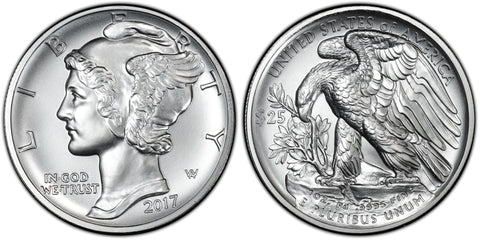Bullion Products
Gold Bullion

In 1986, the United States began striking gold and silver bullion coins to compete with world bullion coins such as the Canadian Maple Leaf, the South African Krugerrand, and others. The value of these coins was intended to be tied directly to their metal value, although in some cases (where mintages were low) a collector market has developed. The bullion value of these coins far outstrips their face value.
Known as "American Eagles" because of the family of eagles on the reverse, U.S. gold bullion coins are available in Uncirculated and Proof versions, as well as in a number of different sets. Proof coins may be ordered by the general public directly from the Mint. Uncirculated coins are distributed by selected representatives, who then make them available to the secondary market.
From 1986-1991, the date was shown in Roman numerals; from 1992 on, Arabic numerals are used.
The obverse of the U.S. gold bullion coins follows the artistic design created by Augustus Saint-Gaudens for the $20 Gold Double Eagles issued from 1907-1933, inclusive. Miley Busiek created the reverse design.
The metal content of each denomination consists of 22 Karat gold (.9167% pure).

American Gold Buffalo coins were first struck in 2006 in response to growing demand for a more pure gold coin (99.99% pure as opposed to the 99.93% pure American Eagle Gold coins). The design of this coin copies faithfully that of James Earle Fraser's "Buffalo Nickel" (issued from 1913 to 1938), with the addition of the motto "In God We Trust" to the bottom left reverse. Initially, only one ounce versions were produced, but fractional issues appeared in 2008. Each coin bears a face value that is far below the coin's bullion value. Both Mint State and Proof versions have been produced, as well as special collector sets of different denominations.
Mint State American Gold Buffalo coins are distributed through a select group of dealers, who sell them to the secondary market. Proof American Gold Buffalo coins are available directly from the U.S. Mint at a premium over their bullion value.
The value of American Gold Buffalo coins are directly affected by the price of gold, which fluctuates daily. In addition, the supply of gold and the demand for American Gold Buffalo coins has resulted in disruptions in the Mint's ability to produce the coins.
Silver Bullion

In 1986, the United States began striking gold and silver bullion coins to compete with world bullion coins such as the Canadian Maple Leaf, the South African Krugerrand, and others. The value of these coins was intended to be tied directly to their metal value, although in some cases (where mintages were low) a collector market has developed. The bullion value of these coins far outstrips their face value.
Known as "American Eagles" because of the family of eagles on the reverse, U.S. silver bullion coins are available in Uncirculated and Proof versions, as well as in a number of different sets. Proof coins may be ordered by the general public directly from the Mint. Uncirculated coins are distributed by selected representatives, who then make them available to the secondary market.
The obverse of the U.S. silver bullion coins follows the artistic design created by Adolphe A. Weinman for the Half Dollars issued from 1916-1947, inclusive. John Mercanti created the reverse design.
Each Silver Eagle has a face value of $1 and contains exactly one ounce of pure silver in an alloy of 99.93% silver and .07% copper.
A limited number of Mint State 2004 Silver Eagles were encapsulated by the Professional Coin Grading Service along with an insert signed by former NASA astronaut, Kathryn D. Sullivan. A portion of the proceeds was dedicated to a science museum located in Ohio.
The rarest coin in the series is the 1995-W Proof, with a mintage of only 30,125 pieces.
Platinum Bullion

In 1997, the United States began striking platinum coins to compete with other world bullion coins. U.S. platinum bullion coins are available in Uncirculated and Proof versions in four denominations: $10, $25, $50, and $100. The true value of these coins is tied directly to their intrinsic metal value, although in a few cases (where mintages are low) collectors will pay a significant premium over the bullion value. Generally, however, the bullion value of these coins far outstrips their face value.
Proof coins may be ordered by the general public directly from the Mint, either as single coins or as a complete set of the four different denominations. Uncirculated coins are distributed by selected representatives, who then make them available to the secondary market based on the prevailing bullion value of platinum.
John M. Mercanti designed the obverse of the U.S. platinum bullion coins using the head of the Statue of Liberty. In keeping with the Mint's "American Eagles" theme, new reverses are developed each year - always with an eagle incorporated into the design.
The metal content of each denomination consists of 99.95% pure platinum.
Mintmarks appear on the reverse, but positions vary from year to year. U.S. platinum bullion coins have been struck at the following mints:
Philadelphia
West Point
BEWARE - Counterfeit examples of the 2002 1/10 ounce platinum coins began being offered in 2003.
Palladium Bullion
*Subject to Availability*
